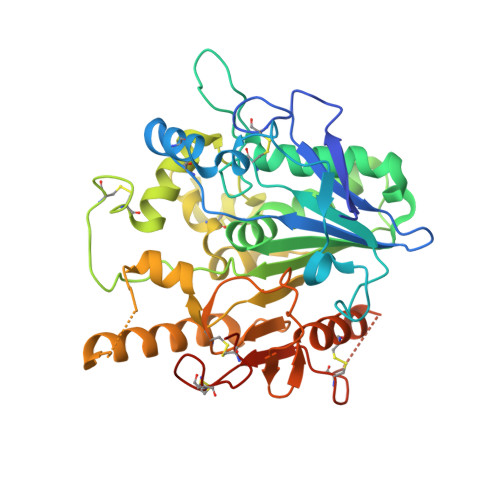Structural Insights into Notum Covalent Inhibition.
Zhao, Y., Svensson, F., Steadman, D., Frew, S., Monaghan, A., Bictash, M., Moreira, T., Chalk, R., Lu, W., Fish, P.V., Jones, E.Y.(2021) J Med Chem 64: 11354-11363
- PubMed: 34292747
- DOI: https://doi.org/10.1021/acs.jmedchem.1c00701
- Primary Citation of Related Structures:
7ARG, 7B2V, 7B2Y, 7B2Z, 7B37, 7B3F - PubMed Abstract:
The carboxylesterase Notum hydrolyzes a palmitoleate moiety from Wingless/Integrated(Wnt) ligands and deactivates Wnt signaling. Notum inhibitors can restore Wnt signaling which may be of therapeutic benefit for pathologies such as osteoporosis and Alzheimer's disease. We report the identification of a novel class of covalent Notum inhibitors, 4-(indolin-1-yl)-4-oxobutanoate esters. High-resolution crystal structures of the Notum inhibitor complexes reveal a common covalent adduct formed between the nucleophile serine-232 and hydrolyzed butyric esters. The covalent interaction in solution was confirmed by mass spectrometry analysis. Inhibitory potencies vary depending on the warheads used. Mechanistically, the resulting acyl-enzyme intermediate carbonyl atom is positioned at an unfavorable angle for the approach of the active site water, which, combined with strong hydrophobic interactions with the enzyme pocket residues, hinders the intermediate from being further processed and results in covalent inhibition. These insights into Notum catalytic inhibition may guide development of more potent Notum inhibitors.
Organizational Affiliation:
Division of Structural Biology, Wellcome Centre for Human Genetics, University of Oxford, Oxford OX3 7BN, U.K.



















